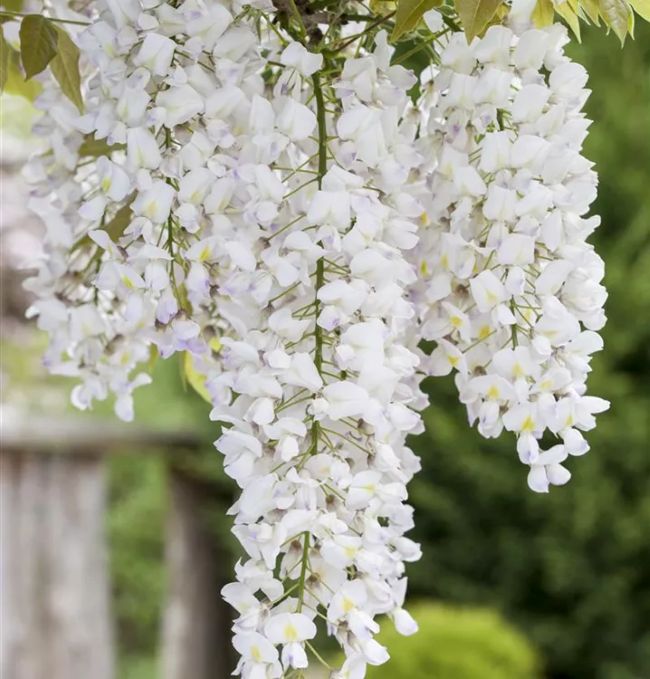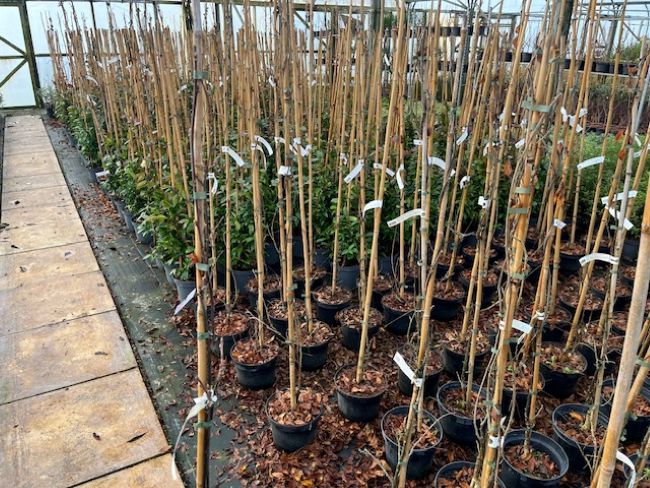Description
Wisteria floribunda f. alba ‘Shiro-noda’ is a deciduous, climbing vine native to Japan, prized for its spectacular, cascading clusters of pure white flowers. These fragrant blooms appear in late spring to early summer and can measure up to 60 cm (2 feet) in length, creating a dramatic, elegant display. Once established, ‘Shiro-noda’ can reach heights of up to 9 meters (30 feet) or more if left unpruned, and it will twine clockwise around its support. The pinnate leaves emerge bright green in spring, maturing to a deeper green over the summer, and often provide attractive yellow tones in fall.
Garden Advice Notes
Soil type
- Ideal Soil: Prefers moist, well-drained soil that is moderately fertile and rich in organic matter.
- pH Range: Slightly acidic to neutral (around 6.0 to 7.0).
- Drainage: Good drainage is crucial to prevent waterlogging, which can lead to root rot. In heavier soils, consider incorporating organic material such as compost to improve structure and drainage.
Location
- Light: Wisteria flourishes in full sun (at least 6 hours of direct sunlight daily). It can tolerate partial shade, but flowering may be reduced.
- Climate: Hardy in temperate regions; typically suitable for USDA Zones 5–9 (or equivalent). Adequate winter chill helps encourage flowering.
- Support: Provide a sturdy support, such as a pergola, trellis, or arbor. These vines can become heavy over time, so ensure the support is robust.
Pest and disease problems
- Aphids: May cluster on new shoots and flower buds, causing stunted growth. Control with insecticidal soap or strong water sprays.
- Scale insects: Appear as small, flattened bumps on stems. Treat with horticultural oils or systemic insecticides if infestations are severe.
- Crown rot / Root rot: Can occur in poorly drained soils. Avoid overwatering and ensure good drainage.
- Honey fungus: A potential threat if present in the soil; keep plants healthy and stress-free to reduce susceptibility.
Propagation
- Seed propagation: Possible, but seedlings can take many years to bloom, and offspring may not be true to the parent form.
- Layering: A reliable method. Bend a low-growing stem to the ground, slightly wound it, cover with soil, and keep it moist until roots form.
- Softwood or semi-ripe cuttings: Taken in late spring or summer. Dip cuttings in rooting hormone and place in a well-draining mix.
- Grafting: Common in commercial nurseries to ensure reliable bloom.
Pruning, cutting back and dividing
- Pruning: Wisterias require regular pruning to promote flowering and control size. A common approach is to prune twice a year:
- Summer Prune: After flowering, shorten new growth back to about 15 cm (6 inches).
- Winter Prune: In late winter, further reduce these same shoots to just 2–3 buds.
- Cutting back: Avoid severely cutting into old wood, as this can delay flowering. Focus on removing long, whippy new growth.
- Dividing: Wisterias are not typically divided due to their woody root systems. If necessary, layering or cuttings are preferred over attempting to split an established vine.
Please note our plants in most instances are delivered by our own GardenAdvice expert gardeners. Our standard UK delivery charge is £25 or if you are a MyGardenTeam member delivery is free
Our plants are guaranteed for 24 months for more details Click Here


























Reviews
There are no reviews yet.